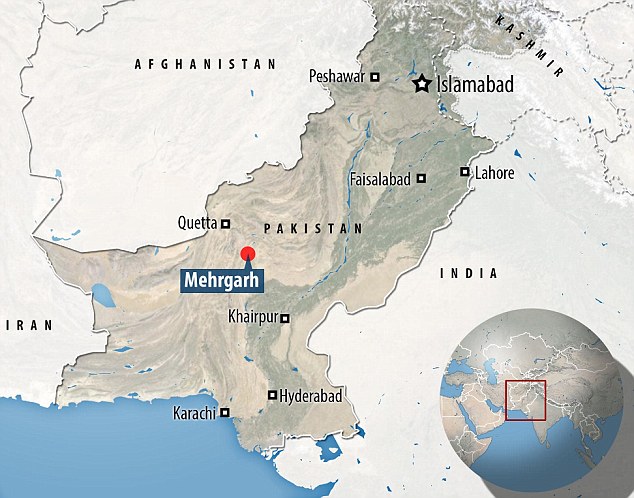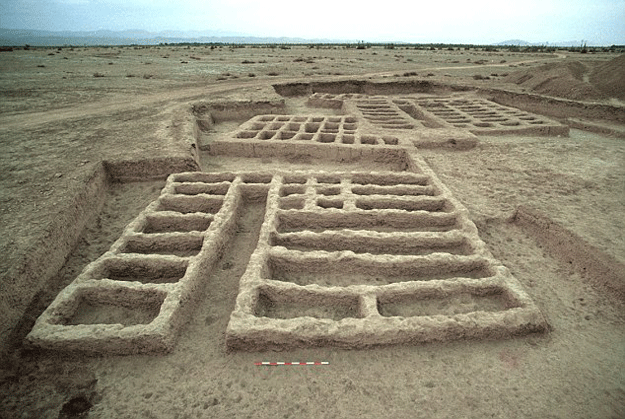Revealed: 6,000-year-old amulet was created with ancient technology that is STILL used by Nasa today
- Ornament was first discovered at Neolithic village of Mehragarh, Pakistan
- New imaging techniques reveal how the artefact was made
- Lost-wax casting is a method for making duplicate metal objects
- Modern version of the process - known as 'investment casting' was used in components for ISS, Curiosity Mars rover and various spacecraft
By
LIBBY PLUMMER FOR MAILONLINE
PUBLISHED: 13:34 GMT, 16 November 2016 | UPDATED: 18:01 GMT, 16 November 2016
An ancient amulet has been shown to be the oldest known example of a metalwork technique still used by
Nasa.
The 6,000-year-old amulet, originally discovered in the Neolithic village of Mehragarh, Pakistan, is thought to be the earliest example of lost-wax casting - a method for making duplicate metal objects.
The artefact was analysed as part of a new study using a technique known as 'photoluminescence imaging' in order to determine exactly how it was made.
The 6,000-year-old amulet, originally discovered in the Neolithic village of Mehragarh, Pakistan, is thought to be the earliest example of lost wax casting - a method for making duplicate metal objects
WHAT IS MEHRAGARH?
Mehragarh is an archaeologial site in Pakistan, located to the west of the Indus River Valley.
It was first discovered in 1974.
It is known as one of the most important archaeological sites from the early Neolithic period.
The area was settled various times between 7000 BC and 2000 BC.
The site was excavated extensively until 1986 and then again from 2000 to 2007.
The area is known for early evidence of farming.
The local population fashioned tools using copper ore.
The amulet, which has the unassuming inventory number of MR.85.03.00.01, is one of a selection of lost-wax cast ornaments found at the site.
This involves shining a light on the artefact and then measuring the amount of light that bounces back.
As different materials reflect different amounts of light, this enabled researchers to pinpoint the exact materials used to make the amulet.
The research was carried out by researchers from Ipanema - a European centre for studying archaeological materials.
The group is based at the SOLEIL synchrotron - a type of particle accelerator, located near Paris, France.
The process revealed that the amulet was cast as a single piece, leading the researchers to conclude that it was made used a process known as lost-wax casting.
This involves creating a replica of the original object using wax, and then creating a mold around it.
This is then heated up, the liquid wax poured out and molten metal poured in.
Once cool, the mold is broken apart, leaving the newly formed metal object in tact.
The amulet is one of several lost-wax cast ornaments discovered during the excavation of the site at Mehrgarh
The study published in
Nature, found that the amulet was made by pouring very pure copper melt into a pre-prepared clay mould using lost-wax casting.
The copper absorbed a small amount of oxygen during the processing which explains the presence of microscopic copper oxide 'bristles' inside the amulet.
High spatial dynamics photoluminescence (PL, top) and optical microscopy (bottom) images of an area of a portion of one spoke of the wheel-shaped amulet. The images reveal microscopic copper oxide bristles that hint at how the artefact was made
6,000-year-old amulet was created with ancient technology used by Nasa
Lost-cost waxing can be used to produce far more complicated designs that the wheel-shaped amulet.
It is still the most popular method used for art foundry today but its use stretches much further.
'It is also today the highest precision metal forming technique— under the name ‘investment casting’—in aerospace, aeronautics and biomedicine, for high-performance alloys from steel to titanium,' explain the researchers.
+6
The archaeological site at Mehragarh in Pakistan where the amulet was found
+6
The amulet was found at Mehragarh - an archaeologial site in Pakistan, located to the west of the Indus River Valley
The technique has been used to create numerous components used on the International Space Station and the Curiosity Mars rover, as well as Nasa's now-defunct space shuttle.
The process was also used to create parts of the Messenger spacecraft, which orbited Mercury between 2011 and 2015.
+6
A modern version of the technique - known as ‘investment casting' - has been used to produce numerous components on the Curiosity Mars Rover (illustration pictured), the international space station and various spacecraft














 ....
....


